| Artillery Hill Tourist Cabins, Diner, and Filling Station Built ca. 1937 |
|
by Debbie Robison January 13, 2019 |
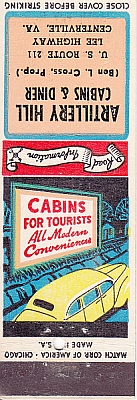
Artillery Hill Cabins Ben L. Cross built a diner, tourist cabins, and filling station/garage on the south side of Lee Highway just west of Centreville during the Great Depression. He was able to purchase the 16.66 ac parcel in 1936 from G. Raymond Ratcliffe by obtaining a loan from the Peoples National Bank of Manassas.[1] Money was saved by repurposing an old streetcar used in the diner’s construction. Cross offered comfort, convenience, and home cooked food; and promised that A Cordial Welcome Always Awaits You.[2] The cabins, diner and garage were located near the southwest corner of the intersection of Lee Highway and present–day Old Centreville Road (formerly Manassas Road). 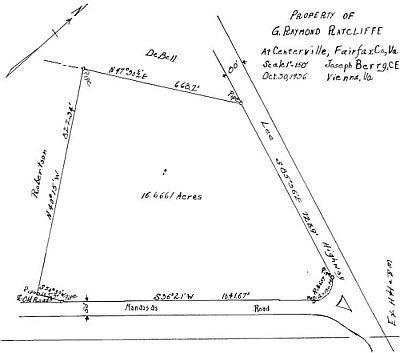
Land Plat by Joseph Berry, CE [3] As car ownership increased in the 1920s and 1930s, more and more people traveled to the country by automobile. The location Cross chose was ideal for attracting tourists traveling down the concrete highway from Washington D. C. to view the Manassas battlefield. When this section of Lee Highway was constructed in 1925 to straighten the route, the road construction cut through a Civil War–era fort. Remnants of the fort, called Artillery Hill by the mid–1930s, were on Cross’s property.[4] Civil War Fort at Centreville, March 1862, Photographer George N. Barnard, Image Courtesy Library of Congress Cross’s diner existed by 1937. It appears in aerial photographs taken that year by the U.S. Department of Agriculture. 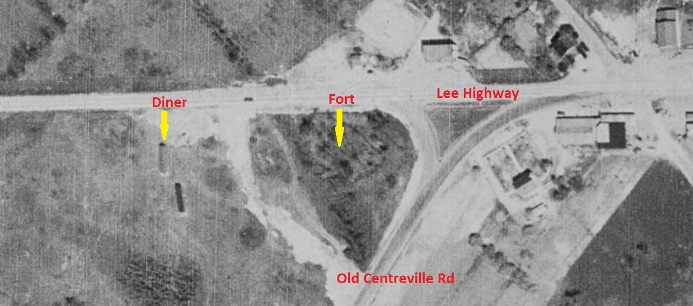
Artillery Hill Diner, 1937, US Department of Agriculture, Image Courtesy County of Fairfax |
| DINER CONSTRUCTION |
|
Artillery Hill Diner and Sinclair Oil Filling Station and Garage, Later the El Chico Drive-In Restaurant, 1968, Photographer William Edmund Barrett, Image Courtesy Virginia Room, Fairfax County Public Library Like many diners of the period, the Artillery Hill Diner was constructed using an old streetcar. Cross had the trolley cut in half, with each section placed about 10’ apart on a cement block foundation. The trolley halves formed the outer walls of the diner, while a structure built down the center completed the building. This configuration gave the diner extra width. Cross likely purchased the streetcar from the Arlington and Fairfax Railway. The streetcars were manufactured by the J. G. Brill Company, headquartered in Philadelphia. Identifying features of the streetcar include the placement of the doors, rivet construction, and the style of the roof, body, and bumpers. The roof was a Brill Plain Arch Roof, invented by J. G. Brill in 1910 to be lighter and stronger than the previous roof type. The new design increased head room, allowed for a better connection with the roof-mounted ventilating systems, and made it possible to increase the window height and improve the window arrangement. The metal roof was covered with a single piece of canvas, without seams, to make the roof waterproof.[5] Interior of Car with Brill Plain Arch Roof, 1910, Brill Magazine, Courtesy Google Books Sometime after 1940, the original Artillery Hill Diner streetcar windows were replaced with larger picture windows. The following photo shows the diner with the type of widows that were often a feature of a Brill streetcar. 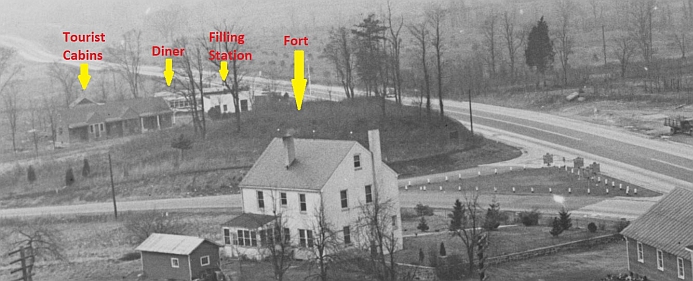
Tourist Cabins, Diner, and Filling Station, ca. 1940, Image Courtesy Dennis Hogge Close up of Tourist Cabins, Diner, and Filling Station Showing Original Streetcar Windows, ca. 1940, Image Courtesy Dennis Hogge |
| ARLINGTON & FAIRFAX RAILWAY |
|
Increased vehicle ownership had a detrimental effect on interurban electric railways, including the Arlington & Fairfax Railway that had a terminus at the Town of Fairfax. The Arlington & Fairfax Railway operated from 1927 until early 1937 when the company was reorganized.[6] The company was auctioned off and became the Arlington & Fairfax Auto Railroad.[7]The new company ran streetcars that could run on both rails and road. The sale and conversion to a different vehicle type may have provided Cross with an opportunity to purchase the streetcar, since the timing of the diner’s construction coincided with the sale of the railway. The Arlington & Fairfax Railway was formed in 1927 when the Washington–Virginia Railway went bankrupt and the trolley line and streetcars were split up for sale.[8] During World War I, the Washington–Virginia Railway purchased 22 electric streetcars from the J. G. Brill Company. Most were needed to support the new rail extension to Fort Humphreys (now Fort Belvoir), which was completed in 1918.[9] The type of streetcar Cross used to construct his diner matches these streetcars. J. G. Brill Co. manufactured an identical model in 1918 for the Philadelphia Liner.[10] Philadelphia Liner Streetcar, 1918, Brill Magazine, Courtesy Google Books Some of the streetcars purchased by the Washington–Virginia Railway ended up in Canada in the 1940s. 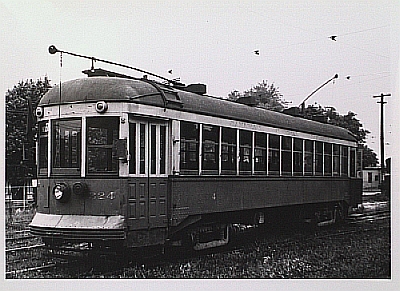
Former Washington–Virginia Railway Streetcar, Image Courtesy St. Catherines Public Library |
| FILLING STATION/GARAGE |
|
The filling station with repair garage was built after the diner. In 1938, Cross leased the land between the fort and the diner to the Sinclair Refining Company. The lease agreement noted that the beginning point of the boundary would be approximately 200’ feet from Civil War Fortress. Cross had already built the service station at the time of the lease. It was constructed of cinder block and measured 24’x26’. Well water and septic were connected to the building.[11] |
| CHANGE OF OWNERSHIP AND OPERATORS |
|
Cross sold the land next to the diner, where the remnants of the fort were located, to Robert Dye in 1943. The agreement required Cross to relinquish the lease to Sinclair Oil.[12] Cross sold the diner to James and Helen Sullivan in 1944.[13] The diner was operated by Everett and Elva Simpson at least by 1946 when they filed for a fictitious name for their company, trading as “Artillery Hill Diner.”[14] In 1962, the diner was operated by Clarence Wilber and Harry Blevens as El Chico Drive In.[15] The fictitious name was renewed in 1966 when the restaurant was run by Paul Kennet Wyatt.[16] By 1971 the diner, garage, and cabins had been demolished.[17] |
| ENDNOTES |
|
[1] Fairfax County Deed Book (FX DB) I12(295)473, 9 Nov 1936. Deed from G Raymond Ratcliffe and Lillian, his wife to Ben L Cross and Sarah, his wife. [2] Artillery Hill Cabins & Diner matchbook. [3] FX DB I12(295)392, 2 Nov 1936. Deed from Sherwood, Swetnam, and Farr to G Raymond Ratcliffe and Lillian, his wife. [4] Herndon Observer, 03 Dec 1936, p. 1, Ben Cross buys Old Fort property. [5] Brill Magazine, Vol. 4, p. 290, Philadelphia, October 1910, Courtesy Google Books. [6] “Arlington–Fairfax Railway's Charter Approved by State,” The Washington Post, 14 Jul 1927, p. 2; Also, Railway Age, 1938, Vol. 105, p. 125. [7] Fairfax Herald, 26 Feb 1937, p. 1. Arlington & Fairfax Auto Railroad directors chosen. [8] “Virginia Suburban Line Sale is Confirmed,” The Washington Post, 28 Jul 1927, p. 2; Also, “Arlington-Fairfax Rail Stockholders File Property Deed,” The Washington Post, 06 Aug 1927, p. 2. [9] Electric Railway Journal, 1918, Vol. 52, No. 9, p 400, as viewed at https://library.si.edu/digital-library/book/electricrailway521918newy?width=80%&height=60%&inline=true Also, Electric Railway Journal, 1918, Vol. 52, no. 12, p. 534. [10] Brill Magazine, Vol. 11, No. 10, p. 281, May 1918, Courtesy Smithsonian Libraries, as viewed at https://library.si.edu/digital-library/book/brillmagazine11191721phil. [11] FX DB H13(320)526, 24 Oct 1938. Lease agreement from Ben Cross and Sarah Cross, his wife, to Sinclair Refining Company. [12] Fairfax County Deed Book (FX DB) 411:111, 21 July 1943. Deed from Ben and Sarah Cross to Robert and Louise Dye. [13] Fairfax County Deed Book (FX DB) 432:208, 15 Jun 1944. Deed from Ben and Sarah Cross to James and Helen Sullivan. [14]Fairfax County Record of Fictitious Names, Book 3, page 144, Fairfax County Circuit Court. [15] Fairfax County Record of Fictitious Names, Book 14, page 58, Fairfax County Circuit Court. [16] Fairfax County Record of Fictitious Names, Book 17, page 474, 710, Fairfax County Circuit Court. [17] 1971 aerial photo, viewed on www. Historicaerials.com. |

| Home |
 |